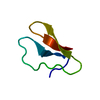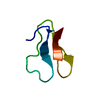+ Open data
Open data
- Basic information
Basic information
| Entry | Database: PDB / ID: 1pb5 | ||||||
|---|---|---|---|---|---|---|---|
| Title | NMR Structure of a Prototype LNR Module from Human Notch1 | ||||||
 Components Components | Neurogenic locus notch homolog protein 1 | ||||||
 Keywords Keywords |  SIGNALING PROTEIN / SIGNALING PROTEIN /  Notch signaling / LIN12/Notch repeat / calcium-binding domain / protein module / Notch signaling / LIN12/Notch repeat / calcium-binding domain / protein module /  disulfide bond disulfide bond | ||||||
| Function / homology |  Function and homology information Function and homology informationDefective LFNG causes SCDO3 / coronary sinus valve morphogenesis / cardiac right atrium morphogenesis / cardiac right ventricle formation / growth involved in heart morphogenesis / Notch signaling pathway involved in regulation of secondary heart field cardioblast proliferation /  cell differentiation in spinal cord / retinal cone cell differentiation / venous endothelial cell differentiation / arterial endothelial cell differentiation ...Defective LFNG causes SCDO3 / coronary sinus valve morphogenesis / cardiac right atrium morphogenesis / cardiac right ventricle formation / growth involved in heart morphogenesis / Notch signaling pathway involved in regulation of secondary heart field cardioblast proliferation / cell differentiation in spinal cord / retinal cone cell differentiation / venous endothelial cell differentiation / arterial endothelial cell differentiation ...Defective LFNG causes SCDO3 / coronary sinus valve morphogenesis / cardiac right atrium morphogenesis / cardiac right ventricle formation / growth involved in heart morphogenesis / Notch signaling pathway involved in regulation of secondary heart field cardioblast proliferation /  cell differentiation in spinal cord / retinal cone cell differentiation / venous endothelial cell differentiation / arterial endothelial cell differentiation / cardiac chamber formation / epithelial cell fate commitment / negative regulation of pro-B cell differentiation / Pre-NOTCH Processing in the Endoplasmic Reticulum / negative regulation of inner ear auditory receptor cell differentiation / mitral valve formation / cell migration involved in endocardial cushion formation / glomerular mesangial cell development / negative regulation of photoreceptor cell differentiation / negative regulation of cell proliferation involved in heart valve morphogenesis / cell differentiation in spinal cord / retinal cone cell differentiation / venous endothelial cell differentiation / arterial endothelial cell differentiation / cardiac chamber formation / epithelial cell fate commitment / negative regulation of pro-B cell differentiation / Pre-NOTCH Processing in the Endoplasmic Reticulum / negative regulation of inner ear auditory receptor cell differentiation / mitral valve formation / cell migration involved in endocardial cushion formation / glomerular mesangial cell development / negative regulation of photoreceptor cell differentiation / negative regulation of cell proliferation involved in heart valve morphogenesis /  regulation of somitogenesis / inhibition of neuroepithelial cell differentiation / endocardium morphogenesis / atrioventricular node development / foregut morphogenesis / regulation of cell adhesion involved in heart morphogenesis / distal tubule development / MAML1-RBP-Jkappa- ICN1 complex / regulation of epithelial cell proliferation involved in prostate gland development / auditory receptor cell fate commitment / positive regulation of aorta morphogenesis / negative regulation of endothelial cell chemotaxis / neuroendocrine cell differentiation / collecting duct development / negative regulation of extracellular matrix constituent secretion / positive regulation of transcription of Notch receptor target / cellular response to tumor cell / positive regulation of apoptotic process involved in morphogenesis / compartment pattern specification / vasculogenesis involved in coronary vascular morphogenesis / T-helper 17 type immune response / regulation of somitogenesis / inhibition of neuroepithelial cell differentiation / endocardium morphogenesis / atrioventricular node development / foregut morphogenesis / regulation of cell adhesion involved in heart morphogenesis / distal tubule development / MAML1-RBP-Jkappa- ICN1 complex / regulation of epithelial cell proliferation involved in prostate gland development / auditory receptor cell fate commitment / positive regulation of aorta morphogenesis / negative regulation of endothelial cell chemotaxis / neuroendocrine cell differentiation / collecting duct development / negative regulation of extracellular matrix constituent secretion / positive regulation of transcription of Notch receptor target / cellular response to tumor cell / positive regulation of apoptotic process involved in morphogenesis / compartment pattern specification / vasculogenesis involved in coronary vascular morphogenesis / T-helper 17 type immune response /  regulation of extracellular matrix assembly / endocardial cell differentiation / epithelial to mesenchymal transition involved in endocardial cushion formation / cardiac ventricle morphogenesis / Constitutive Signaling by NOTCH1 t(7;9)(NOTCH1:M1580_K2555) Translocation Mutant / positive regulation of smooth muscle cell differentiation / cardiac left ventricle morphogenesis / mesenchymal cell development / epidermal cell fate specification / coronary vein morphogenesis / negative regulation of collagen biosynthetic process / cardiac vascular smooth muscle cell development / negative regulation of myotube differentiation / somatic stem cell division / left/right axis specification / negative regulation of cardiac muscle hypertrophy / negative regulation of cell adhesion molecule production / interleukin-17-mediated signaling pathway / positive regulation of endothelial cell differentiation / secretory columnal luminar epithelial cell differentiation involved in prostate glandular acinus development / endocardium development / apoptotic process involved in embryonic digit morphogenesis / positive regulation of cardiac epithelial to mesenchymal transition / Pre-NOTCH Processing in Golgi / cardiac epithelial to mesenchymal transition / negative regulation of calcium ion-dependent exocytosis / cardiac muscle cell myoblast differentiation / cellular response to follicle-stimulating hormone stimulus / pericardium morphogenesis / cardiac atrium morphogenesis / negative regulation of catalytic activity / neuronal stem cell population maintenance / regulation of extracellular matrix assembly / endocardial cell differentiation / epithelial to mesenchymal transition involved in endocardial cushion formation / cardiac ventricle morphogenesis / Constitutive Signaling by NOTCH1 t(7;9)(NOTCH1:M1580_K2555) Translocation Mutant / positive regulation of smooth muscle cell differentiation / cardiac left ventricle morphogenesis / mesenchymal cell development / epidermal cell fate specification / coronary vein morphogenesis / negative regulation of collagen biosynthetic process / cardiac vascular smooth muscle cell development / negative regulation of myotube differentiation / somatic stem cell division / left/right axis specification / negative regulation of cardiac muscle hypertrophy / negative regulation of cell adhesion molecule production / interleukin-17-mediated signaling pathway / positive regulation of endothelial cell differentiation / secretory columnal luminar epithelial cell differentiation involved in prostate glandular acinus development / endocardium development / apoptotic process involved in embryonic digit morphogenesis / positive regulation of cardiac epithelial to mesenchymal transition / Pre-NOTCH Processing in Golgi / cardiac epithelial to mesenchymal transition / negative regulation of calcium ion-dependent exocytosis / cardiac muscle cell myoblast differentiation / cellular response to follicle-stimulating hormone stimulus / pericardium morphogenesis / cardiac atrium morphogenesis / negative regulation of catalytic activity / neuronal stem cell population maintenance /  tissue regeneration / regulation of stem cell proliferation / negative regulation of oligodendrocyte differentiation / positive regulation of astrocyte differentiation / calcium-ion regulated exocytosis / pulmonary valve morphogenesis / heart trabecula morphogenesis / negative regulation of biomineral tissue development / endoderm development / coronary artery morphogenesis / negative regulation of cell-cell adhesion mediated by cadherin / prostate gland epithelium morphogenesis / tissue regeneration / regulation of stem cell proliferation / negative regulation of oligodendrocyte differentiation / positive regulation of astrocyte differentiation / calcium-ion regulated exocytosis / pulmonary valve morphogenesis / heart trabecula morphogenesis / negative regulation of biomineral tissue development / endoderm development / coronary artery morphogenesis / negative regulation of cell-cell adhesion mediated by cadherin / prostate gland epithelium morphogenesis /  luteolysis / cardiac muscle tissue morphogenesis / ventricular trabecula myocardium morphogenesis / negative regulation of myoblast differentiation / negative regulation of cell migration involved in sprouting angiogenesis / transcription regulator activator activity / positive regulation of BMP signaling pathway / tube formation / negative regulation of stem cell differentiation / Loss of Function of FBXW7 in Cancer and NOTCH1 Signaling / positive regulation of keratinocyte differentiation / astrocyte differentiation / inflammatory response to antigenic stimulus / positive regulation of Ras protein signal transduction / negative regulation of ossification luteolysis / cardiac muscle tissue morphogenesis / ventricular trabecula myocardium morphogenesis / negative regulation of myoblast differentiation / negative regulation of cell migration involved in sprouting angiogenesis / transcription regulator activator activity / positive regulation of BMP signaling pathway / tube formation / negative regulation of stem cell differentiation / Loss of Function of FBXW7 in Cancer and NOTCH1 Signaling / positive regulation of keratinocyte differentiation / astrocyte differentiation / inflammatory response to antigenic stimulus / positive regulation of Ras protein signal transduction / negative regulation of ossificationSimilarity search - Function | ||||||
| Biological species |   Homo sapiens (human) Homo sapiens (human) | ||||||
| Method |  SOLUTION NMR / distance geometry, torsion angle dynamics, SOLUTION NMR / distance geometry, torsion angle dynamics,  simulated annealing simulated annealing | ||||||
| Model type details | minimized average | ||||||
 Authors Authors | Vardar, D. / North, C.L. / Sanchez-Irizarry, C. / Aster, J.C. / Blacklow, S.C. | ||||||
 Citation Citation |  Journal: Biochemistry / Year: 2003 Journal: Biochemistry / Year: 2003Title: Nuclear Magnetic Resonance Structure of a Prototype Lin12-Notch Repeat Module from Human Notch1 Authors: Vardar, D. / North, C.L. / Sanchez-Irizarry, C. / Aster, J.C. / Blacklow, S.C. | ||||||
| History |
|
- Structure visualization
Structure visualization
| Structure viewer | Molecule:  Molmil Molmil Jmol/JSmol Jmol/JSmol |
|---|
- Downloads & links
Downloads & links
- Download
Download
| PDBx/mmCIF format |  1pb5.cif.gz 1pb5.cif.gz | 149.6 KB | Display |  PDBx/mmCIF format PDBx/mmCIF format |
|---|---|---|---|---|
| PDB format |  pdb1pb5.ent.gz pdb1pb5.ent.gz | 128.3 KB | Display |  PDB format PDB format |
| PDBx/mmJSON format |  1pb5.json.gz 1pb5.json.gz | Tree view |  PDBx/mmJSON format PDBx/mmJSON format | |
| Others |  Other downloads Other downloads |
-Validation report
| Arichive directory |  https://data.pdbj.org/pub/pdb/validation_reports/pb/1pb5 https://data.pdbj.org/pub/pdb/validation_reports/pb/1pb5 ftp://data.pdbj.org/pub/pdb/validation_reports/pb/1pb5 ftp://data.pdbj.org/pub/pdb/validation_reports/pb/1pb5 | HTTPS FTP |
|---|
-Related structure data
| Similar structure data |
|---|
- Links
Links
- Assembly
Assembly
| Deposited unit | 
| |||||||||
|---|---|---|---|---|---|---|---|---|---|---|
| 1 |
| |||||||||
| NMR ensembles |
|
- Components
Components
| #1: Protein/peptide | Mass: 3717.964 Da / Num. of mol.: 1 / Fragment: First LNR module Source method: isolated from a genetically manipulated source Source: (gene. exp.)   Homo sapiens (human) / Plasmid: pMM / Production host: Homo sapiens (human) / Plasmid: pMM / Production host:   Escherichia coli (E. coli) / Strain (production host): BL21DE3plysS / References: UniProt: P46531 Escherichia coli (E. coli) / Strain (production host): BL21DE3plysS / References: UniProt: P46531 |
|---|---|
| #2: Chemical | ChemComp-CA / |
-Experimental details
-Experiment
| Experiment | Method:  SOLUTION NMR SOLUTION NMR | ||||||||||||||||
|---|---|---|---|---|---|---|---|---|---|---|---|---|---|---|---|---|---|
| NMR experiment |
| ||||||||||||||||
| NMR details | Text: The structure was determined using triple-resonance NMR spectroscopy |
- Sample preparation
Sample preparation
| Details |
| |||||||||||||||
|---|---|---|---|---|---|---|---|---|---|---|---|---|---|---|---|---|
| Sample conditions |
| |||||||||||||||
Crystal grow | *PLUS Method: other / Details: NMR |
-NMR measurement
| Radiation | Protocol: SINGLE WAVELENGTH / Monochromatic (M) / Laue (L): M | ||||||||||||||||||||
|---|---|---|---|---|---|---|---|---|---|---|---|---|---|---|---|---|---|---|---|---|---|
| Radiation wavelength | Relative weight: 1 | ||||||||||||||||||||
| NMR spectrometer |
|
- Processing
Processing
| NMR software |
| ||||||||||||||||||||||||
|---|---|---|---|---|---|---|---|---|---|---|---|---|---|---|---|---|---|---|---|---|---|---|---|---|---|
| Refinement | Method: distance geometry, torsion angle dynamics,  simulated annealing simulated annealingSoftware ordinal: 1 | ||||||||||||||||||||||||
| NMR representative | Selection criteria: minimized average structure | ||||||||||||||||||||||||
| NMR ensemble | Conformer selection criteria: all calculated structures submitted,structures with the lowest energy Conformers calculated total number: 50 / Conformers submitted total number: 16 |
 Movie
Movie Controller
Controller













 PDBj
PDBj











